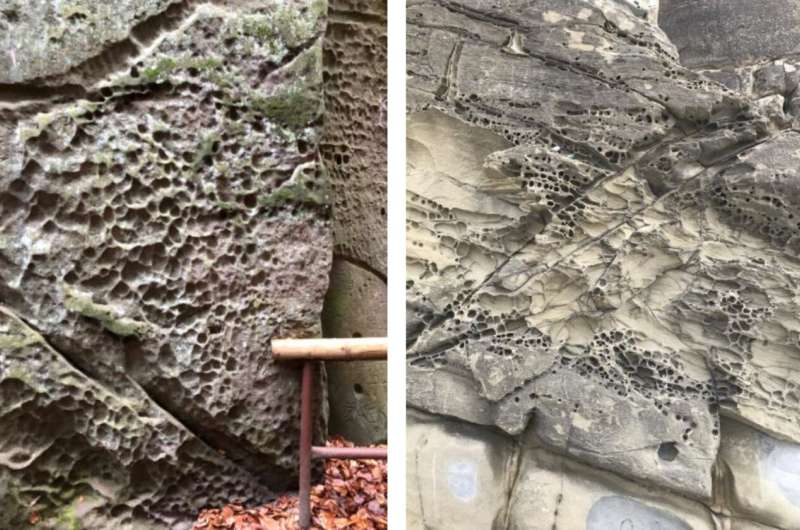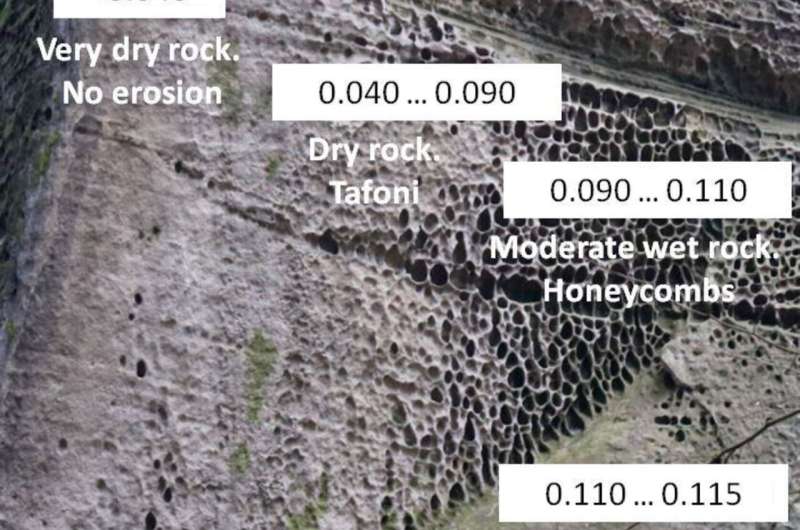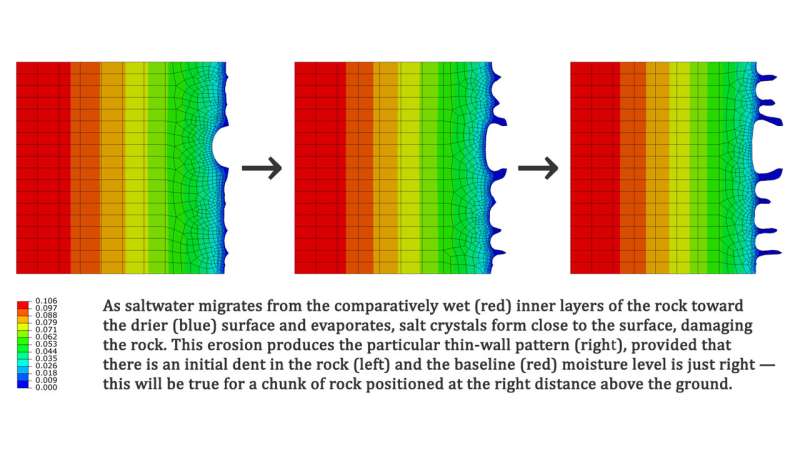This article has been reviewed according to Science X's editorial process and policies. Editors have highlighted the following attributes while ensuring the content's credibility:
fact-checked
trusted source
proofread
Computer simulation explains mysterious rock patterns seen from Czech Republic to Mars

In geology, honeycombs are an intriguing pattern of small cavities on rock surfaces found in coastal regions, wet areas, deserts, and even on Mars. They are fascinating to look at in natural objects and a bane of historic buildings and monuments. Despite a hundred years of research, scientists are still not sure how honeycombs come about.
A study in Geosciences by two Skoltech researchers describes a computer simulation of rock weathering that reproduces the puzzling hollows-and-ridges pattern and pinpoints the conditions that promote—or deter—its formation. The main factor at play is saltwater evaporation.
"Honeycomb structures on rock faces have been closely studied over the past hundred years, but there's still no conclusive understanding of how they form," the lead author of the study, Associate Professor Alexander Safonov of Skoltech Materials, said. "A number of hypotheses have implicated wind and water erosion, ice and salt crystal formation, sharp temperature fluctuations, and even fungi in honeycomb formation."
"In this study, we adopt the saltwater evaporation hypothesis, mathematically simulate the process, and identify the "Goldilocks zone' in which honeycomb erosion happens: not too dry, but not too wet either," Safonov continued.
"In terms of monument conservation, our findings may help pinpoint the particular spots on historic buildings, statues, etc. that are most vulnerable to honeycomb erosion, as well as identify safer locations for positioning these objects. Estimating the life span of a projected structure is another possibility."
The various types of weathering are all known to be capable of damaging rock, but until now no laboratory experiment or mathematical model could reproduce the intricate network of cavities that defines honeycomb weathering. In their study, the researchers managed to simulate just that. What's more, the simulation even explains the characteristic smooth rock face often seen below the weathered region and the unaffected area above it.

The simulation is two-dimensional and assumes certain standard evaporation conditions, reported in prior research. Deep inside the rock, the moisture content is deemed constant, regardless of how much water evaporates from the rock face. The intuition behind this is that the rock can freely draw water from the soil. This corresponds to conditions, for example, in the Czech Republic's Apolena Rock City, famous for its honeycomb formations.
The baseline value for the moisture content in the innermost layers of the rock actually varies depending on how far above the ground a particular chunk of rock is, because water has to overcome gravity to rise up.
In the simulation, honeycombs form when there's an initial dent in the rock and the baseline moisture content falls into a certain window.
"The trick is that water does not necessarily evaporate on the surface," study co-author and Skoltech Ph.D. student Kirill Minchenkov explained. "In fact, there are three basic scenarios. Higher up, the rock is too dry and water starts evaporating well below the surface. This happens slowly, and the few salt crystals that form are deep within and scarcely do any damage."
"No erosion. Then there's the opposite case: If the rock is too wet, which will be the case closer to the ground or the sea, the evaporation happens outside, the process is intense, and much salt is left behind. But this salt is deposited right on the surface and does not damage the rock either. Finally, there is an intermediate case when water evaporates at a moderate depth, depositing salt slightly below the surface—this is crucial—and thereby chipping away small pieces of the rock."

The mechanism behind honeycomb formation could be seen in terms of an interplay between these scenarios. The rock face as a whole may fit into the Goldilocks zone—the third scenario—and thus be susceptible to erosion. But any initially present protrusions on the rock will gradually be exaggerated, because they fall into the first scenario ("too dry").
Below them, evaporation happens at a greater depth from the surface and causes less erosion, so the protrusions persist while the surrounding rock gets eaten away. A similar line of reasoning explains how, in the case of a very wet rock, it is only the protrusions themselves that get eroded, resulting in a very smooth rock face often seen on patches below natural honeycomb formations, somewhat closer to sea level.
More information: Alexander Safonov et al, Mathematical Simulation of Honeycomb Weathering via Moisture Transport and Salt Deposition, Geosciences (2023). DOI: 10.3390/geosciences13060161
Provided by Skolkovo Institute of Science and Technology




















